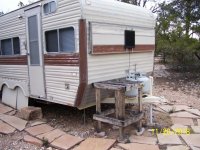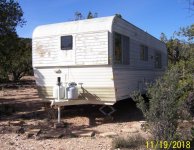Most devices which remain energized with the key off draw about 1 milliamp (0.001), each.
A no load AGM self-discharge is about 2% per month…at cold temperatures.
This is based upon a clean battery case. Crud on the case will allow current flow, post to post and greatly accelerate / augment discharge.
If connected to a Sportster, (through 2006, with carb) this is load with the key off:
Voltage regulator 1 milliamp (0.001 amp)
Speedometer 1 milliamp (0.001 amp)
Tachometer (if equipped) 1 milliamp (0.001 amp)
TSM (non-security models) 1 milliamp (0.001 amp)
TSSM (disarmed) 3 milliamp (0.003 amp)
TSSM (armed) 3 milliamp (0.003 amp)
TSSM (storage mode) 1 milliamp (0.001 amp)
HFSM 1 milliamp (0.001 amp)
Security siren 20 milliamp (0.020 amp): Siren will draw for 2-24 hours from time motorcycle battery is connected and 0.05 milliamperes (0.00005 amp) once siren battery is charged.
I posted a Yuasa link on a Sportster forum, but the link is no longer valid.
The sample battery in that link for discharge rate is an AGM and is 50% discharged in 60 days with a drain equal to the load of a voltage regulator, speedo, tach, and TSSM. With only a regulator, speedo (no tach) and TSM, the load is only ~ 3 milliamps and 50% discharge would be about 120-150 days. For 2014 up Sportsters, with CANBus, there would be additions for BCM, etc.
Without a spec from the Can-AM factory service manual, we could use a moderately equipped auto, such as a Kia Soul spec of 50 milliamps, as the max to be expected (1/2 that more likely).
0.050 amp x 12 volts = 0.6 watt maximum parasitic consumption (0.3 watt more likely)
State of Charge (AGM battery)
12.8+ 100%
12.6 75%
12.3 50%
12.0 25%
11.8 Zero
Bottom line:
A. Best to not go over 30 days without a charge, 60 days maximum
B. The Amazon link by Cobwebs would do the job. A larger one could be detrimental, due to the possibility of an overcharge
C. An unregulated solar panel should be checked for over voltage...perhaps connect a couple days a week and check voltage.
I have AGMs, well past their warranty period, serving well in travel trailers at my ranch.
They are used for LED lighting, water pump, circulation fans (summer) and cell phone recharge, typically 3 days out of 30.
When I arrive and check the voltage, it can be in the low to mid 15 volt range...which is over typical voltage regulator limits of 13.8 to 14.8, even though the 5 watt panels are regulated.
Before I switched to AGM from lead acid, distilled water had to be added at least twice a year. In 2004 I gave a 2001 Jeep to a daughter with a new battery. I put the old lead-acid battery in one of the trailers and used it for 10 years. In almost 20 years, I have only replaced one solar panel...but not the solar panel's fault that cattle like to chew on things; including wiring, screen tents, Nylon window screens, etc.
May be more than you wanted to read, but some of the info may be helpful.



